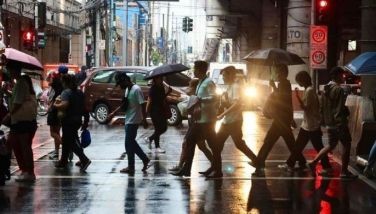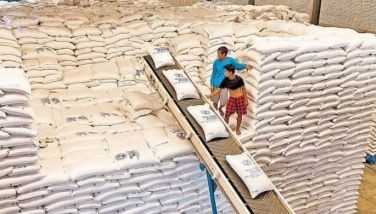Tons of aid undelivered
MANILA, Philippines - From Metro Manila to the Visayas, relief goods are piling up, with logistical and security problems preventing their distribution to desperate victims of Super Typhoon Yolanda.
Delivery of the relief goods finally got off to a laborious start yesterday, as government forces began bringing the supplies from the airports of Cebu and Tacloban to victims.
A military officer who asked not to be named said that days after Yolanda’s powerful storm surge flattened much of Tacloban, many victims still had not received aid.
The officer said the National Disaster Risk Reduction and Management Council (NDRRMC) should drop its relief distribution protocol and allow the military and police to distribute relief goods directly to hungry typhoon victims in isolated areas.
Apart from relief goods that have accumulated at airports, foreign and local medical teams and relief workers have also been stranded.
The day after Super Typhoon Yolanda struck Eastern Visayas, a team of 15 doctors and logistics experts was ready to fly to Tacloban, the worst hit city, to help.
On Tuesday, five days into what could be the country’s deadliest disaster, they were still waiting to leave.
Aid is finally coming to Tacloban: medical supplies, pallets of water and food piled on trucks, planes and ferries, sent by the Philippine government and countries around the world.
But the scale of the disaster and challenges of delivering the assistance mean few in the city, strewn with debris and corpses, have received any help.
A team from Medecins Sans Frontieres, complete with medical supplies, arrived in Cebu on Saturday looking for a flight to Tacloban, but had not left by Tuesday.
A spokesman for the group said it was “difficult to tell†when they would be able to leave.
“We are in contact with the authorities, but the (Tacloban) airport is only for Philippine military use,†said Lee Pik Kwan.
At the medics’ intended destination, it was getting out that was the problem. Thousands of people hoping for rescue camped at the airport and ran onto the tarmac when planes came in, surging past a broken iron fence and a few soldiers and police trying to control them. Only a few hundred made it aboard.
“We need help. Nothing is happening,†said Aristone Balute, an 81-year-old who did not get on a flight out of the city. “We have not eaten since yesterday afternoon.†Her clothes were soaked from the rain, and tears streamed down her face.
Foreign television journalists yesterday reported the supposed disorganized relief operations and the lack of presence of local authorities in typhoon-hit areas.
CNN anchor Anderson Cooper described the situation in Tacloban as “miserable†and “very, very bad.â€
“I’m just surprised. I expected on this Day 5, I thought maybe I have gotten here very late, that things will be well on hand. It does not seem like that. People are desperate. People do not have any place for shelter. It’s very difficult for people to get food,†Cooper said in a report for the news program “The Lead.â€
“It is a very desperate situation, among the most desperate I have seen in covering disasters in the last couple of years,†he added.
Cooper was later quoted by the Twitter account of his show “Anderson Cooper 360º†as saying that “the people in Tacloban have great dignity and deserve better than what they have gotten.â€
“It is demolition, not a construction job here,“ he added.
Cooper said he has seen people who are staying close to the bodies of their loved ones, which nobody has picked up because nobody was there to do so. He claimed not having seen a large Philippine military presence around the area.
“It is a miserable situation here and it does not seem to be getting better day by day,†the CNN anchor said. “As to who’s in charge of the Philippine side of the whole operation, that is not really clear.â€
For his part, BBC correspondent Jon Donnison was quoted as saying that “there does not yet seem to be an effective operation to get help to those in need.â€
Officials have previously assured the public that efforts are underway to reach all residents who are in need of assistance.
Malacañang admitted yesterday that some remote areas were not yet reached by relief assistance and that more repacking centers would be established by the Department of Social Welfare and Development so that relief goods would not run out.
President Aquino himself told CNN in an interview Tuesday night via teleconference that the government would need to deliver 50,000 relief packs every two days due to the magnitude of devastation caused by the typhoon.
Cabinet Secretary Jose Rene Almendras said the process of bringing relief items to typhoon victims would be a “huge production line†and that after repacking of the goods, there were obstacles in transporting and distributing them to the victims.
“There has never been anything at the magnitude of what we are trying to do now. Not in size, not in volume, not even the breadth of it. The logistics alone – we discussed over two and a half hours how to move the goods, where to move goods, how many trucks we need from packing center to shipping center. It is not a small amount of work that needs to be done,†Almendras said in a press briefing.
But as regards the areas that were not reached, Almendras said these were “very least.â€
“As a matter of fact, I think, we are down to four, three… around four more specific areas that need to be reached. I would imagine that these would be reached by (yesterday), by chopper,†Almendras said.
But he said this did not mean the areas were isolated because communication had been established.
“As far as reach of goods or repair or clearing, that’s ongoing. The good news is all the major roads are now open so things are flowing already. The DPWH (Department of Public Works and Highways) was very aggressive in fixing the roads or temporary bridges that toppled,†Almendras said.
He said more repacking centers were being set up in strategic areas nationwide to accelerate the processing of goods.
Meanwhile, Almendras said most of the foreign aid for typhoon victims had not yet reached the Philippines.
He said some of the items were not necessarily relief items but support equipment and goods for emergency teams.
“They are self contained. They will feed themselves and operate on their own without resources from us,†Almendras said.
He said the only foreign relief goods that were ready for distribution came from Taiwan and these items would be brought to Ormoc City.
Bigger planes and ships will also be directed to Cebu rather than stop in Manila to make the delivery of assistance more efficient, Almendras said.
An Associated Press reporter drove through the town for around seven kilometers yesterday, seeing more than 40 bodies. He saw no evidence of any organized delivery of food, water or medical supplies, though piles of aid have begun to arrive at the airport.
Some people were lining up to get water from a hose, presumably from the city supply.
“There is a huge amount that we need to do. We have not been able to get into the remote communities,†UN humanitarian chief Valerie Amos said in Manila.
“Even in Tacloban, because of the debris and the difficulties with logistics and so on, we have not been able to get in the level of supply that we would want to. We are going to do as much as we can to bring in more,†Amos said.
Presidential spokesman Edwin Lacierda said relief goods were getting into the city, and the supply should increase in the coming days now that the airport and a bridge to the island were open.
“We are not going to leave one person behind – one living person behind,†he said. “We will help, no matter how difficult, no matter how inaccessible.â€
Doctors in Tacloban said they were desperate for medicine. Beside the ruined airport tower, at a small makeshift clinic with shattered windows, Army and Air Force medics said they had treated around 1,000 people for cuts, bruises, lacerations and deep wounds.
“It’s overwhelming,†said Air Force Capt. Antonio Tamayo. “We need more medicine. We cannot give anti-tetanus vaccine shots because we have none.â€
The longer survivors go without access to clean water, food, shelter and medical help, the greater chance of disease breaking out and people dying as a result of wounds sustained in the storm.
The official death toll from the disaster rose to 2,275 yesterday, though authorities have said they expect that to rise markedly. They fear estimates of 10,000 dead are accurate and might be low. More than nine million people have been affected across a large swath of the country, many of them made homeless.
Tacloban, a city of about 220,000 people on Leyte island, bore the full force of the winds and the tsunami-like storm surges. Most of the city is in ruins, a tangled mess of destroyed houses, cars and trees. Malls, garages and shops have all been stripped of food and water by hungry residents.
Damaged roads and other infrastructure are complicating the relief efforts. Government officials and police and Army officers are in many cases among the victims themselves, hampering coordination.
In Matnog, Sorsogon, the port for ferries leaving to another hard-hit island, Samar, dozens of trucks piled high with aid were waiting to cross.
In Manila, soldiers tossed pallets of water, medical supplies and foods into C-130 planes bound for the disaster area.
The United Nations said it had released $25 million in emergency funds to pay for emergency shelter materials and household items, and for assistance with the provision of emergency health services, safe water supplies and sanitation facilities.
It’s launching an appeal for more aid.
The aircraft carrier USS George Washington is headed toward the region with massive amounts of water and food, but the Pentagon said it won’t arrive until today. The US also said it is providing $20 million in immediate aid.
Many other countries, including Japan, Australia and Britain, which is sending a Royal Navy vessel with aid, have pledged aid totaling tens of millions of dollars.
For now, relief has come to a lucky few, including Joselito Caimoy, a 42-year-old truck driver. He was able to get his wife, son and three-year-old daughter on a flight out of Tacloban. They embraced in a tearful goodbye, but Caimoy stayed behind to guard what’s left of his home and property.
“People are just scavenging in the streets. People are asking food from relatives, friends. The devastation is too much... the malls, the grocery stories have all been looted,†he said. “They are empty. People are hungry. And they (the authorities) cannot control the people.†– With Alexis Romero, AP
- Latest
- Trending
































